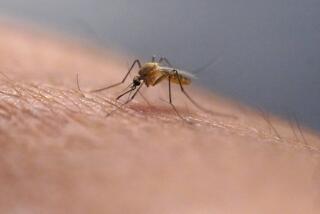Putting Teeth in Efforts to Reduce Dog Bite Cases
Six-year-old Larissa Casillas is terrified of dogs and plagued by bad dreams. And she has good reason to be.
Five months ago, the Placentia youngster approached a neighbor’s Rottweiler to stop it from eating a chocolate ice cream wrapper. The animal pounced, clawing and biting the girl so badly she needed 56 stitches to close the wounds on her head and arms.
Animal control and health experts say Larissa is among a growing number of dog bite victims who are part of a largely unrecognized health problem.
The number of dog bite injuries dwarfs the reported cases of mumps, measles and whooping cough combined, said Dr. Jeffrey Sacks of the federal Centers for Disease Control and Prevention in Atlanta. He has compiled one of the few studies that look at the problem nationwide.
“There’s a lot of risks in life we can’t control, and here’s one that can be [controlled], very simply and with very little effort or money,” Sacks said.
In response to the work of Sacks and others, the American Humane Assn. co-sponsored a conference in Anaheim this week to promote awareness about the dangers of dog bites and encourage the public to take steps to prevent such attacks from happening.
While some animal control experts label the problem “rampant,” others note that statistics on dog bites often are sketchy.
In an eight-year span ending in 1994--the most recent year for which the CDC compiled such information--the number of dog bites requiring medical attention increased 37%. In 1994, more than 800,000 dog bites nationwide required medical care, according to the CDC study.
“It’s rampant, but because we haven’t been talking about it, the victims feel that they are the only ones. This is actually happening everywhere,” said Gini Barrett, director of the American Humane Assn.’s western regional office, and a conference speaker.
In Orange County, about 300 people suffer dog bites in an average month, said Judy Maitlen, director of the Orange County Animal Control Agency, who keeps tabs on attacks that require medical attention. While that figure remains stable, Maitlen said she is seeing more attacks involving serious injury.
“There have been no fatal injuries but several very serious ones that required 60, 80 stitches and more,” Maitlen said. “The face bites, in particular, cause huge amounts of scarring that can last a lifetime.”
Animal control experts including Barrett attribute the more severe attacks to the propensity of urban dwellers to select pets for personal protection.
“I think we have an affinity here in Southern California for large, aggressive breeds of dogs that is unparalleled with anywhere else in the nation,” Barrett said. “Crimes and a fear of crimes is a part of our culture.”
Barrett and others also note that any dog, even the meekest breed, can attack.
Some cities, including Los Angeles, don’t compile statistics on dog bites because there is no money to do so, county health officials said. Maitlen and others say the figures that are available are likely to be low. Many bites go unreported and untreated, she said.
Another indicator of the problem: About one-third of all homeowner claims now involve dog bites, prompting some insurance agencies to raise premiums on policyholders with problem dogs, according to the nonprofit, Los Angeles-based Insurance Information Service. State Farm Insurance also co-sponsored the Anaheim conference.
Before the attack on his daughter, David Casillas never much considered the threat posed by dogs. But in the months since, he was surprised to notice others dealing with the consequences of a dog bite.
“It’s weird. We keep hearing and seeing stories of dogs attacking kids on the news,” he said. “It seems like this happens all the time.”
In the wake of the attack, animal control officials ordered the Rottweiler that attacked Larissa be neutered and remain leashed whenever off the owner’s property. Casillas said he believes these penalties were too lenient given the severity of the attack.
He does not want the dog to be euthanized, just moved out of the neighborhood, and he believes the best safety measure is to educate people to be responsible pet owners.
“Putting the dog to sleep doesn’t do anything. The owner will just get a new dog,” he said.
The CDC study shows that children younger than 12 are especially vulnerable, more likely to be bitten than adults and three times more likely to require medical attention, according to the 1996 survey. A second CDC study found that a majority of the 279 people who died as a result of a dog attack from 1979 to 1994 were children.
Placentia mailman Pablo Aguayo, who says he considers himself an expert after having been chased “too many times by unchained dogs,” had some advice for pet owners.
“Make sure your gates are shut and locked,” said Aguayo, whose daughter participated in dog safety demonstrations for children during the Anaheim conference.
Times staff writer Martha Willman also contributed to this report.
(BEGIN TEXT OF INFOBOX / INFOGRAPHIC)
Keeping Kids Bite-Proof
Here are some steps children can take to stay safe around dogs:
* Never approach an unfamiliar dog.
* Don’t run from a dog and scream.
* Remain motionless when approached by an unfamiliar dog.
* If knocked over by a dog, roll into a ball and lie still.
* Never play with a dog unless supervised by an adult.
* Immediately report to an adult any stray dog displaying unusual behavior.
* Avoid eye contact with a dog.
* Do not disturb a dog that is sleeping, eating or caring for puppies.
* Allow a dog to see and sniff you before you pet it.
* If you are bitten, immediately report the bite to an adult.
Source: Centers for Disease Control
More to Read
Sign up for Essential California
The most important California stories and recommendations in your inbox every morning.
You may occasionally receive promotional content from the Los Angeles Times.











